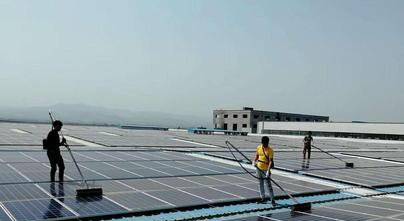Cleaning Solar Panels
Safety Precautions
Before starting the cleaning work, make sure that both the solar panels and the inverter are powered off to avoid the risk of electric shock. This can be achieved by turning off the power switch of the inverter and disconnecting the circuits connected to the solar panels. Meanwhile, wear personal protective equipment such as insulating gloves and safety glasses to prevent accidents during the cleaning process.
Choosing the Right Time and Weather Conditions
The best time for cleaning is in the early morning or evening. At this time, the temperature of the solar panels is relatively low, which can reduce the risk of glass cracking caused by temperature differences, and the sunlight is weak, avoiding eye injuries caused by reflected light during the cleaning process. Avoid cleaning when the sun is shining brightly or during high-temperature periods. Additionally, choose a windless or slightly breezy day to prevent dust from reattaching to the surface of the solar panels during the cleaning process.
Preparing Cleaning Tools and Materials
Prepare a soft cleaning brush, such as a wool brush or a sponge brush, and avoid using a hard brush to scratch the tempered glass surface of the solar panels. A clean, soft cloth is needed for wiping water stains and residual dirt. Also, prepare an appropriate amount of mild cleaner, such as a special solar panel cleaner or neutral soapy water. Never use a cleaner containing corrosive ingredients to avoid damaging the surface coating and internal battery structure of the solar panels.
Cleaning Steps
First, use the cleaning brush to gently sweep away large particles of debris such as dust, leaves, and bird droppings on the surface of the solar panels. Pay attention to being gentle and start from the top of the panel and brush downward in one direction to avoid scratches caused by repeated back-and-forth wiping. For stubborn dirt that is difficult to sweep away, spray the diluted cleaner on the dirty area and then gently wipe it with a cloth. Finally, rinse it with clean water and make sure there is no cleaner residue left. After cleaning, let the solar panels dry naturally or wipe them dry with a clean, dry cloth to avoid water stains that may affect the power generation efficiency.

Cleaning the Solar Inverter
Cleaning the Exterior
Use a dry, soft cloth to wipe the exterior of the inverter to remove dust and stains on the surface. For stubborn stains, you can gently wipe them with a wet cloth dipped in a small amount of neutral cleaner, but avoid getting water into the vents and terminal blocks of the inverter to prevent short circuits and damage to the internal electronic components.
Cleaning the Heat Sinks
The heat sinks of the inverter are crucial for maintaining the normal operating temperature of the device. Check whether the heat sinks are clogged with dust. If so, use a compressed air canister or a small vacuum cleaner to suck the dust out of the gaps in the heat sinks to ensure good ventilation of the heat sinks, so that the inverter can effectively dissipate heat during operation and prevent performance degradation or failure due to overheating.
Checking and Cleaning the Terminal Blocks
Carefully check whether the terminal blocks of the inverter are loose, oxidized, or corroded. If dirt or oxide is found on the terminal blocks, gently polish it off with fine sandpaper, and then wipe it with a clean cloth dipped in a small amount of electrical contact cleaner to ensure good connections, reduce contact resistance, and prevent heat generation and power loss caused by poor connections.
Through regular and meticulous cleaning and maintenance of solar panels and solar inverters, the overall performance and reliability of solar power generation systems can be significantly improved, providing a strong guarantee for the continuous and efficient utilization of solar energy. Meanwhile, it can also reduce potential losses caused by equipment failures and performance degradation. During the cleaning process, always follow safety operating procedures and the recommendations of the equipment manufacturer to ensure the effectiveness and safety of the cleaning work.
GET A QUOTE